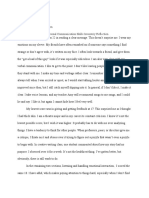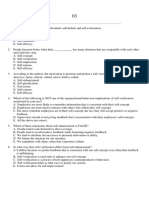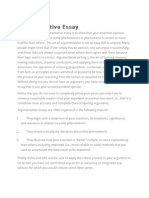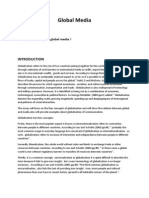Causal Argument Essay Revised
Causal Argument Essay Revised
Uploaded by
api-318525544Copyright:
Available Formats
Causal Argument Essay Revised
Causal Argument Essay Revised
Uploaded by
api-318525544Original Title
Copyright
Available Formats
Share this document
Did you find this document useful?
Is this content inappropriate?
Copyright:
Available Formats
Causal Argument Essay Revised
Causal Argument Essay Revised
Uploaded by
api-318525544Copyright:
Available Formats
Aggressive Marketing and Obesity
Aggressive Marketing and Obesity
Wilson Badillo III
Montgomery College
ThispaperwaspreparedforENGL10232867taughtbyProfessorStorm.
Aggressive Marketing and Obesity
Aggressive Marketing and Obesity
A health problem called obesity has been on the rise this last decade and there are many
theories on what can possibly be causing this outbreak. Food availability, sugars and addiction
are commonly to blame but the real culprit is marketing. Aggressive marketing by food
companies is making the greatest impact on the disease obesity. People may think otherwise but
aggressive marketing is the source of obesity and obesity ties to the marketers deceitful ways.
All the marketing fast food companies do with their unhealthy products ties to most of the other
causes of obesity. When they market their products often they are providing plenty of misleading
claims to go along with the product their trying to get consumers to buy. Companies that provide
these misleading claims have no remorse and are willing to do anything to move their product.
Preying on innocent children is one of the things they are willing to do. Child targeting by these
companies is the beginning root for obesity starting Americas children young exposing them to
unhealthy products. These products ultimately will lead those children to unhealthy lifestyles and
start their lives overweight and even obese at times. What they are doing is wrong but they are
having huge success and making plenty of money to fund themselves. With all the money they
make they are able to advertise even more and find ways to be even more deceitful than they
already are. Although there is many causes for obesity there is one in specific that is leading the
charge, aggressive marketing campaigns is the source and the biggest cause of obesity in
America.
Obesity is spreading more and more due to negligence of these companies and the
carelessness involved when advertising their products. According to Cohen, Collins, Hunter,
Ghosh-Dastidar & Dubowitz (2015), It may be no coincidence that between 1980 and 2000,
while the food industry learned how to sell larger quantities of low-nutrient processed foods
Aggressive Marketing and Obesity
merely by manipulating their placement, rates of obesity in the United States doubled (p.1446).
The food industrys aggressive marketing techniques to sell more of their low-nutrient products
are effective and will make them money, but at what cost? They are refusing to acknowledge the
negative impact they can impose on their consumers. A lot of their marketing techniques come
from misleading health claims. These companies want to give their consumers any kind of reason
to purchase their product, even if that reason is invalid. Faulty research claims and support for
their products often are displayed as one of their many marketing techniques pulling in gullible
consumers into buying their products. Companies take advantage of their consumers all the time
and the consumer is just left in the dark buying their product. Peoples lack of knowledge on
nutrition is one way companies capitalize on consumers ignorance. Consumers often fall for
products that are fat free, low carb, and fruit flavored. All these terms look good in their
eyes but what they actually contain is hidden. Most of the time these fat free and low carb
products are indeed what they say but often times loaded with sugar or calories taking away the
purpose of eating the product to promote a healthier lifestyle. Information like that is not
advertised because these companies sole purpose is to sell their product. With all the misleading
health claims certain individuals can be easily influenced into buying their products. These
products that they are buying to fit their nutritional needs may or may not do the job. If they
never learn how to really spot the products they need to fit their nutritional goals reaching their
desired health can be very difficult and discouraging to them. When consumers buy a product
they expect that product to fulfill a purpose and work properly. When people buy some of these
products they can end up being nothing as it was advertised to be. This eventually leads the
consumers back to not even trying to have a healthy diet because what is supposed to work is not
Aggressive Marketing and Obesity
working for them. Their misleading health claims are making themselves plenty of money but
also ruining peoples lives at the same time.
Another method these companies use in their aggressive marketing tactics is audience
targeting, especially children. Mueller, S., Carlsohn, Mueller, J., Baur, & Mayer, (2016) explains
in his article Overweight and obesity are increasing health problems that are not restricted to
adults only. In the developed countries, the prevalence of childhood overweight and obesity was
7.9% in 1990 and is estimated to be as high as 14.1% in 2020 (pg.1) In order to sell more of
their product they prey on children who are innocent and easily influenced. The food industry
spends a lot of money to advertise their products to young people. These products that are being
advertised are mostly high in calories, sugar, and sodium. Many of the products are energy dense
fast foods, sugary breakfast cereals and all generally nutrient poor foods. This marketing towards
the youth is connected to Americas unhealthy diet and problems with weight today. As
mentioned before they use their misleading healthy claims like a great source of vitamins, and
a great source of fiber continuously failing to inform the consumer on the important facts
about their product like calories and amounts of sugar. Children are easily influenced making
them very vulnerable to the markets aggressive advertising. All thats needed to influence a child
are some cartoon characters and celebrities which will get children thinking they want that food,
regardless of its nutritional value. Sugary cereals are great examples with all the different
mascots advertising as the face of cereal. Flashy and colorful commercials are influencing
Americas children into wanting to eat their foods. These companies take advantage of the fact
that children are innocent and vulnerable to these things and are not ready to be making their
own decisions. With these companies jumping on the fact that Americas children are vulnerable
to their aggressive marketing, American children are beginning their bad habits and cravings
Aggressive Marketing and Obesity
early which can transfer over into adulthood. Being raised and surrounded by all of the
advertising and unhealthy foods can make their unhealthy habits hard to break. According to
Ball, Kovarik and Leidy (2015) According to the most recent National Health and Nutrition
Examination Survey data, almost one third of American young people are overweight or obese.
Approximately 80% of youth who are obese will become overweight and obese adults if left to
their own accord (p. 1). With so much of Americas youth being obese and with such a high rate
of that obesity translating into their adulthood this disease is becoming a real problem. The youth
targeting being done by these advertising companies is not helping when Americas youth is
already having problems with weight management. Overweight and obesity are fast spreading
health problems that are not restricted to adults only.
With their marketing techniques these food industries are making a lot of money. With all
the money they make they spend a lot of it towards marketing even more effectively. They do
things with their money like sponsor major scientists and obtain involvement in major health
organizations to make their companies and product seem even better than they already tried to
portray it. With scientists in their advertising their product seems even more reliable than ever
influencing many more consumers to purchase their product. Actual health organizations fold
into their money and agree to represent these companies convincing consumers even further that
their product is healthy and nutritional. The money they get from the success of their product
goes towards obtaining even more success for their product through even more advertising. With
so much funding because of their misleading products success competing is hard for a company
that actually sells healthy, accurately described products to compete with them. The only
competition they have are other companies similar to them which is not much competition at all.
Their success with their advertising campaigns makes crushing healthy food competition really
Aggressive Marketing and Obesity
easy. This makes them dominate the advertising industry and expand their companies even
further. With the expansions they can afford through their success through their aggressive
marketing techniques they are able to fill a much larger demand. This success makes their
products much more available and convenient for their consumers ultimately leading them to buy
even more.
Some people think that obesity is not that great of a problem. According to Gostin (2014)
The NCD Alliance pushed hard to have obesity characterized as an epidemic, but states
resisted. From the governmental perspective, framing obesity as an epidemic, implying the need
for an emergency response, went too far; (p. 37) Here Gostin (2014) is trying to explain how
obesity is not the epidemic is sought out to be. Obesity is not instantly claiming lives or
delivering gruesome deaths but obesity is a problem. Some people argue that there are many
other important issues to deal with besides obesity like cancer, diabetes, and so on. Obesity is
similar to those diseases, they all effect peoples lives negatively and have some kind of health
associated risk involved. Obesity is not something like the plague and does not need an
emergency response but it is definitely something that needs to be addressed. Sarah Palin a wellknown American politician said this against Michelle Obamas anti-obesity campaign What
[Michelle Obama] is telling us is she cannot trust parents to make decisions for their own
children, for their own families [about] in what we should eat. ... instead of a government
thinking that they need to take over and make decisions for us according to some politician or
politicians wife priorities, just leave us alone, get off our back and allow us as individuals to
exercise our own God-given rights to make our own decisions (Fisher, 2010, para. 2). Obesity is
effecting thousands of lives, rapidly spreading, and hindering Americas health. Those reasons
alone are enough to have obesity addressed and a solution thought of.
Aggressive Marketing and Obesity
With obesity at an all-time high aggressive marketing is definitely the root of obesity.
Advertising has come to a point where advertising is out of control and nothing is being thought
of besides money. Health should be of primary concern when these advertisements are going on
and the consumers should be fully informed not just partially. With companies misleading their
consumers people are becoming even more vulnerable to the disease. As America goes into
further generations it looks as if obesity is only destined to become worst with all the children
that have been exposed to the marketers deceitful ways. If Americas children fall to their tactics
they will become even more vulnerable to the disease as they mature. These companies and their
deceiving tactics have to stop. Aggressive marketing is visibly noticeable as the main culprit. At
what cost is America allowing these companies to thrive?
Aggressive Marketing and Obesity
8
References
Ball, S., Kovarik, J., & Leidy, H. (2015). Active and Healthy Schools. Physical Educator, 72(2),
224-235.
Cohen, D. A., Collins, R., Hunter, G., Ghosh-Dastidar, B., & Dubowitz, T. (2015). Store Impulse
Marketing Strategies and Body Mass Index. American Journal of Public Health, 105(7),
1446-1452. doi:10.2105/AJPH.2014.302220
Fisher, M. (2010, December 28). Conservatives Split Over Opposition to Michelle Obama's
Obesity Drive. The Wire. Retrieved April 21, 2016 from
http://www.thewire.com/entertainment/2010/12/conservatives-split-over-opposition-tomichelle-obama-s-obesity-drive/21726/
Gostin, L. O. (2014). Public Health Emergencies: What Counts? Hastings Center Report, 44(6),
36-37 2p. doi:10.1002/hast.385
Mueller, S., Carlsohn, A., Mueller, J., Baur, H., & Mayer, F. (2016). Influence of Obesity on Foot
Loading Characteristics in Gait for Children Aged 1 to 12 Years. Plos ONE, 11(2), 1-12.
doi:10.1371/journal.pone.0149924
You might also like
- Homework 1Document7 pagesHomework 1Varun AmesurNo ratings yet
- Persuasive Speech Outline Daniel HanekDocument5 pagesPersuasive Speech Outline Daniel Hanekapi-384224589100% (1)
- Rhetorical Analysis EssayDocument6 pagesRhetorical Analysis Essayapi-268209830100% (2)
- Thursday Night Dilemma Case AnalysisDocument6 pagesThursday Night Dilemma Case AnalysisCarizza Gail Barluado50% (2)
- Outline The Informative SpeechDocument4 pagesOutline The Informative SpeechNiesha LomaxNo ratings yet
- Final ProjectDocument26 pagesFinal Projectapi-309427868No ratings yet
- Final Annotated BibliographyDocument5 pagesFinal Annotated Bibliographyapi-302591262100% (1)
- Rational Emotive Behavior TheoryDocument15 pagesRational Emotive Behavior TheoryJonas C. CardozoNo ratings yet
- How To Analyze An Ad: So You Can Write A Paper 1 Essay or Plan Your IODocument29 pagesHow To Analyze An Ad: So You Can Write A Paper 1 Essay or Plan Your IOArsenia LotivoNo ratings yet
- Interpersonal Communication Skills Inventory ReflectionDocument2 pagesInterpersonal Communication Skills Inventory ReflectionAbby WeberNo ratings yet
- The Great Dictator E28093 A Rhetorical AnalysisDocument7 pagesThe Great Dictator E28093 A Rhetorical AnalysisCallem McDougallNo ratings yet
- Persuasive SpeechDocument5 pagesPersuasive Speechapi-255025847No ratings yet
- Rogerian ArgumentDocument8 pagesRogerian Argumentapi-232536315100% (1)
- Advertising-Advantages & DrawbacksDocument8 pagesAdvertising-Advantages & Drawbacksnor05100% (1)
- Lens EssayDocument9 pagesLens Essayapi-437828833No ratings yet
- Rhetorical AnalysisDocument10 pagesRhetorical Analysisapi-388480954No ratings yet
- PERMADocument4 pagesPERMAlamNo ratings yet
- LGBT SlideDocument4 pagesLGBT SlideAmeera UdeanNo ratings yet
- Ethics of Mobile Behavioral Advertising: Antecedents and Outcomes of Perceived Ethical Value of Advertised BrandsDocument15 pagesEthics of Mobile Behavioral Advertising: Antecedents and Outcomes of Perceived Ethical Value of Advertised BrandsPetru FercalNo ratings yet
- BritaDocument2 pagesBritaBetty BentonNo ratings yet
- Race and World War 2 Posters: An AnalysisDocument9 pagesRace and World War 2 Posters: An AnalysisJDNo ratings yet
- Cristina Marcos, "Dems Unveil Bill To Ban Confederate Monuments On Federal Property." The Hill, August 17, 2017Document21 pagesCristina Marcos, "Dems Unveil Bill To Ban Confederate Monuments On Federal Property." The Hill, August 17, 2017Jackson GibsonNo ratings yet
- Annotated BibliographyDocument3 pagesAnnotated Bibliographyapi-281032430100% (1)
- MHR405 Testbank 03 PDFDocument58 pagesMHR405 Testbank 03 PDFGenevieve D'souzaNo ratings yet
- Week 4Document3 pagesWeek 4ctranquillNo ratings yet
- Synthesis EssayDocument6 pagesSynthesis Essayapi-487466583No ratings yet
- Rhetorical Analysis EssayDocument5 pagesRhetorical Analysis Essayapi-451003900100% (1)
- Final Project MarketingDocument29 pagesFinal Project MarketingSaram ZahidNo ratings yet
- Module 7Document35 pagesModule 7Mishti Ritz MukherjeeNo ratings yet
- What Motivates Consumers To Review A Product Online? A Study of The Product-Specific Antecedents of Online Movie ReviewsDocument6 pagesWhat Motivates Consumers To Review A Product Online? A Study of The Product-Specific Antecedents of Online Movie ReviewsJason VelazquezNo ratings yet
- Persuasive Speech Preparation OutlineDocument5 pagesPersuasive Speech Preparation OutlineVũ TâmNo ratings yet
- Final Synthesis EssayDocument5 pagesFinal Synthesis Essayapi-617074664No ratings yet
- Edoc - Pub - mhr405 Testbank 15 PDFDocument46 pagesEdoc - Pub - mhr405 Testbank 15 PDFSoumitra ChakrabortyNo ratings yet
- Argumentative EssayDocument4 pagesArgumentative Essayhailglee1925No ratings yet
- Impact of Advertising of Urban and Rural Teenager Buying Behaviour..... FinalsDocument63 pagesImpact of Advertising of Urban and Rural Teenager Buying Behaviour..... FinalsRaj Kumar100% (1)
- Book Report: DARE TO FAIL!Document8 pagesBook Report: DARE TO FAIL!Reena JayNo ratings yet
- Argumentative EssayDocument5 pagesArgumentative EssayWaqas CheemaNo ratings yet
- Inflation and Unemployment: What Is The Connection?Document24 pagesInflation and Unemployment: What Is The Connection?sajid93No ratings yet
- Rhetorical Appeals Essay (Final Draft)Document9 pagesRhetorical Appeals Essay (Final Draft)api-285560328No ratings yet
- SOC Price and Cost AnalysisDocument3 pagesSOC Price and Cost AnalysisSaria SanosiNo ratings yet
- BCG Matrix 1Document4 pagesBCG Matrix 1Rahiq AhmedNo ratings yet
- Economic Objections Against AdvertisingDocument5 pagesEconomic Objections Against AdvertisinglindakuttyNo ratings yet
- HS1003 1Document6 pagesHS1003 1KellyNo ratings yet
- Comparative Rhetorical AnalysisDocument7 pagesComparative Rhetorical Analysisapi-308816815No ratings yet
- Nick Davies 6 1Document6 pagesNick Davies 6 1api-337613910No ratings yet
- China Environmental CrisisChina Environmental CrisisDocument23 pagesChina Environmental CrisisChina Environmental CrisisKanza YousufNo ratings yet
- Persuasion Speech OutlineDocument4 pagesPersuasion Speech OutlineHarris1501No ratings yet
- Fallacy ArgumentDocument8 pagesFallacy ArgumentminNo ratings yet
- Eng 335 Paper 1Document7 pagesEng 335 Paper 1api-456330028No ratings yet
- Product Repositioning StrategyDocument7 pagesProduct Repositioning Strategyjayeshpere100% (1)
- Rhetorical AnalysisDocument3 pagesRhetorical AnalysisKunal GoyalNo ratings yet
- Global Global MediaDocument3 pagesGlobal Global MediamichaelNo ratings yet
- QN 11 Market Structure (BTE and Competiton)Document38 pagesQN 11 Market Structure (BTE and Competiton)davidbohNo ratings yet
- What Is A Technical Essay?: Abstract: Many Students Have To Write Technical Essays As Part of Their Coursework. Here WeDocument4 pagesWhat Is A Technical Essay?: Abstract: Many Students Have To Write Technical Essays As Part of Their Coursework. Here WeSaad MemonNo ratings yet
- Annotated BibliographyDocument4 pagesAnnotated Bibliographyapi-490651288No ratings yet
- A Comparison of Healthcare in The United States, The United Kingdom, and GermanyDocument24 pagesA Comparison of Healthcare in The United States, The United Kingdom, and Germanyderpka100% (1)
- Propaganda Model A Critical Approach To Analysing Mass Media Behaviour PDFDocument15 pagesPropaganda Model A Critical Approach To Analysing Mass Media Behaviour PDFMuhammad AchlisonNo ratings yet
- GP Essay (State Surveillance)Document2 pagesGP Essay (State Surveillance)Jodee LeeNo ratings yet
- LGBT and Universal Enjoyment of Human RightsDocument13 pagesLGBT and Universal Enjoyment of Human Rightssteffi felixNo ratings yet
- Civil War EssayDocument3 pagesCivil War Essaykfranceschi1No ratings yet
- The Impact of COVID-19 On The Restaurant IndustryDocument10 pagesThe Impact of COVID-19 On The Restaurant IndustrySonia PaulNo ratings yet
- Pros and Cons of The Legalization of MarijuanaDocument3 pagesPros and Cons of The Legalization of Marijuanaapi-3018615730% (1)
- Types of Advertising: Breaking News English (BNE)Document4 pagesTypes of Advertising: Breaking News English (BNE)SSSS123JNo ratings yet
- B2+ UNITS 7 and 8 CLIL PDFDocument2 pagesB2+ UNITS 7 and 8 CLIL PDFHelena MariñoNo ratings yet
- Brand Storytelling: A Primer: Author: Jonathan GabayDocument26 pagesBrand Storytelling: A Primer: Author: Jonathan GabayNovita Anggraeni100% (3)
- Match The Clues With The Words/expression in The BoxDocument3 pagesMatch The Clues With The Words/expression in The BoxSilvia MontesNo ratings yet
- A Training Project Report MbaDocument37 pagesA Training Project Report Mbanamami saxenaNo ratings yet
- Title of Chapter: NO. NODocument36 pagesTitle of Chapter: NO. NOromeeNo ratings yet
- Procter and Gamble - MarketingDocument10 pagesProcter and Gamble - MarketingIvana Panovska100% (5)
- Untitled 1Document13 pagesUntitled 1Habtamu DesalegnNo ratings yet
- WIA1001-Final U2005405Document1 pageWIA1001-Final U2005405XY LNo ratings yet
- Role of Digital MarketingDocument2 pagesRole of Digital MarketingZarish IlyasNo ratings yet
- Mudra: Communication LimitedDocument18 pagesMudra: Communication LimitedDEEPANSHUNo ratings yet
- Lurker - Idioms by The Free DictionaryDocument1 pageLurker - Idioms by The Free DictionaryMaría del Pilar Mancha BoteNo ratings yet
- Midterm Reviewer P1Document32 pagesMidterm Reviewer P1Roejie BarreraNo ratings yet
- Cover Letter For Beauty Sales AssistantDocument6 pagesCover Letter For Beauty Sales Assistantf5dgrnzh100% (2)
- Scientific Research Report: Digital Marketing and Its Applications in BusinessDocument22 pagesScientific Research Report: Digital Marketing and Its Applications in BusinessGamer và Âm nhạcNo ratings yet
- Report On Promotion CampaignDocument16 pagesReport On Promotion CampaignArun Kumar SatapathyNo ratings yet
- Defshop'S Experiment Proves That The Google Display Network Drives Sales and Brand AwarenessDocument2 pagesDefshop'S Experiment Proves That The Google Display Network Drives Sales and Brand AwarenessAnushka NaikNo ratings yet
- Advertising Social Legal Ethical Economical Aspects 090904225056 Phpapp02Document16 pagesAdvertising Social Legal Ethical Economical Aspects 090904225056 Phpapp02Dhananjay GohilNo ratings yet
- Redressing Architecture: (The Architecture of A Fashion Work/Shop)Document95 pagesRedressing Architecture: (The Architecture of A Fashion Work/Shop)NishantNo ratings yet
- Mountain Dew Mountain DewDocument3 pagesMountain Dew Mountain DewRanjan GuptaNo ratings yet
- Internship Report On Nutri Rich Diabetic BiscuitsDocument53 pagesInternship Report On Nutri Rich Diabetic Biscuitsjon100% (4)
- Gym GroupingDocument5 pagesGym GroupingMohd Ikhwan Amir Hamzah20% (5)
- Defining Branded Content For The Digital AgeDocument42 pagesDefining Branded Content For The Digital AgeGabriela SiquieroliNo ratings yet
- OB Project On AdidasDocument31 pagesOB Project On AdidasvichuicsNo ratings yet
- Digital Marketing Strategy of Creative Consultant During COVID-19 Pandemic: A Qualitative ApproachDocument18 pagesDigital Marketing Strategy of Creative Consultant During COVID-19 Pandemic: A Qualitative ApproachNicholas ZiaNo ratings yet
- Marketing Strategy of Big Bazaar IndiaDocument14 pagesMarketing Strategy of Big Bazaar Indiashailendra0% (1)
- The Batter BlasterDocument19 pagesThe Batter Blasterapi-23712495No ratings yet

























































































